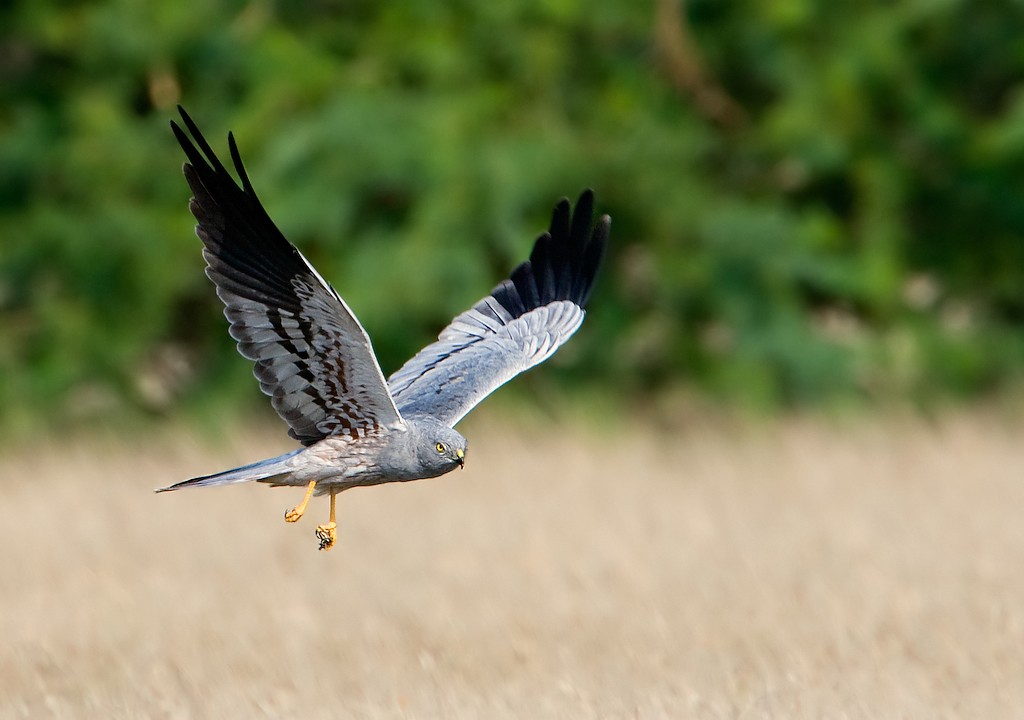Montagu's Harrier
A species of Harriers Scientific name : Circus pygargus Genus : Harriers
Montagu's Harrier, A species of Harriers
Botanical name: Circus pygargus
Genus: Harriers
 Photo By Cks3976 , used under CC-BY-SA-3.0 /Cropped and compressed from original
Photo By Cks3976 , used under CC-BY-SA-3.0 /Cropped and compressed from original Description
Montagu's harrier (Circus pygargus) is a migratory bird of prey of the harrier family. Its common name commemorates the British naturalist George Montagu. 
Size
50 cm
Colors
Brown
Black
Gray
White
Life Expectancy
16 years
Nest Placement
Ground
Feeding Habits
Montagu's Harrier primarily consume small rodents, birds, eggs, reptiles, and large insects such as Orthoptera. They adapt their diet according to local prey availability, with variances like ground squirrels and rabbits in the north, and mostly reptiles and insects in southern Europe. Feeding success can be influenced by rodent population cycles. Montagu's Harrier hunt at low altitudes and speeds, using surprise and agility to capture prey, and will chase if needed. Males feed females and young, passing prey midair, with increased provisioning during the breeding season.
Habitat
Montagu's Harrier's habitat spans temperate, Mediterranean, and boreal regions, favoring open lowland areas such as grasslands, cereal crops, and river valleys. Adapted to both natural and modified landscapes, these birds require large spaces with tall vegetation for cover, yet sparse enough to hunt prey. They utilize perches for breeding and hunting oversight but avoid densely populated areas and are sensitive to disturbance.
Dite type
Carnivorous
Migration Overview
The Montagu's harrier is a long distance migrant. Birds from Eurasia spend the winter in sub-Saharan Africa, while those from the eastern part of the range migrate to the Indian subcontinent. In Europe, the first birds start to move at the beginning of August and most have left by mid-October. They travel over a broad front, crossing the Mediterranean at various points, and only a small number are observed at migration choke points. Western birds don't go further south than the gulf of Guinea, but some eastern birds travel as far as South Africa. In Africa, their diet is composed mostly of insects and birds, and it is possible that they follow locust swarms. Spring return peaks in April, and most birds have arrived by May though there is evidence that first-year juveniles spend their first summer in the winter quarters 
General Info
Feeding Habits
Bird food type
Behavior
It can be both solitary and gregarious at times, both during the breeding season and in winter quarters. A breeding pair may associate with others to form loose colonies, with as many as 30 nests in the same area, sometimes as close as 10 m (33 ft) apart. Semi-colonial nesting is not due to a shortage of nesting sites, but arises rather from the need to provide a better defence against predators. The actual area defended by both partners covers only 300–400 m (980–1,310 ft) around the nest, and in case of colonial nesting the response to predators may be communal. Other species attacked and mobbed include large raptors, corvids, and foxes. Reproduction begins with the return of both partners to the nesting site, at which point both male and female will start displaying. The display consists of various sky-dances and aerobatic figures that vary according to each individual. Both sexes will display, crying loudly, though the males' displays are more frequent and spectacular. Montagu's harriers breed for the first time when two or three years old, but occasionally one-year-old females may attempt to nest. Pairs form on the territory, when returning from migration. As the birds are tied to their former nesting sites, they probably mate with the same partner every year. The nest is built by the female, always in tall vegetation. It is a simple construction made of grass, used only for one season. The female lays 3 to 5 eggs which are incubated for 27–40 days. The young leave the nest after 28–42 days and are independent two weeks later. The males may be polygamous, then having to feed two females and later two broods, either simultaneously or consecutively. 
Distribution Area
This species can still be found throughout most of the Western Palearctic. In most European countries there is at least a small population, except in Norway where it is not present. The breeding range extends as far east as the Urals, whereas the most western population is that of Portugal. Breeding also occurs in northern Africa, mostly in Morocco. In Great Britain, the species is limited to southern England. In Ireland the species is rarely seen, and mainly in the South, although there are a number of breeding records, the most recent from 1971. Despite having a wide distribution, this bird is not common in many areas and has strong populations only in France, Spain, Russia, Belarus and Poland where the greater part of the European population can be found. Breeding sites frequently change, with some sporadic nesting occurring outside known breeding areas, however clear signs of reduced range are apparent and are associated with population decline. 
Species Status
In western Europe, an estimated 70% of breeding pairs nest in agricultural farmlands, especially cereal crops. This makes the Montagu's harrier a very vulnerable species, and very dependent on nest protection. Bird protection non-governmental organizations participate in their protection, in collaboration with concerned landowners. Once a nest is spotted in a field, it can be safeguarded either by relocating it to a safer area or by creating a protected space which will not be harvested. In France and in the Iberian Peninsula, an average 60% of nestlings are saved by this kind of measures. 